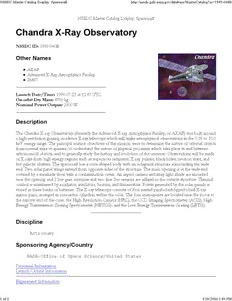
Chandra X-Ray Observatory PDF
Preview Chandra X-Ray Observatory
NSSDC Master Catalog Display: Spacecraft http://nssdc.gsfc.nasa.gov/database/MasterCatalog?sc=1999-040B NSSDC Master Catalog Display: Spacecraft Chandra X-Ray Observatory NSSDC ID: 1999-040B Other Names AXAF Advanced X-Ray Astrophysics Facility 25867 Launch Date/Time: 1999-07-23 at 11:47 UTC On-orbit Dry Mass: 4790 kg Nominal Power Output: 2000 W Description The Chandra X-ray Observatory (formerly the Advanced X-ray Astrophysics Facility, or AXAF) was built around a high-resolution grazing incidence X-ray telescope which will make astrophysical observations in the 0.09 to 10.0 keV energy range. The principal science objectives of the mission were to determine the nature of celestial objects from normal stars to quasars, to understand the nature of physical processes which take place in and between astronomical objects, and to generally study the history and evolution of the universe. Observations will be made of X-rays from high energy regions such as supernova remnants, X-ray pulsars, black holes, neutron stars, and hot galactic clusters. The spacecraft has a cone-shaped body with an octagonal structure surrounding the wide end. Two solar panel wings extend from opposite sides of the structure. The main opening is at the wide end covered by a sunshade door with a contamination cover. An aspect camera and stray light shade are mounted near the opening and 2 low gain antennas and two fine Sun sensors are affixed to the outside structure. Thermal control is maintained by a radiator, insulators, heaters, and thermostats. Power generated by the solar panels is stored in three banks of batteries. The X-ray telescope consists of four nested paraboloid-hyperboloid X-ray mirror pairs, arranged in concentric cylinders within the cone. The four instruments are located near the focus at the narrow end of the cone: the High Resolution Camera (HRC), the CCD Imaging Spectrometer (ACIS), High Energy Transmission Grating Spectrometer (HETGS), and the Low Energy Transmission Grating (LETG). Discipline Astronomy Sponsoring Agency/Country NASA-Office of Space Science/United States Personnel Information Launch/Orbital Information Experiment Information 1 of 2 3/20/2006 1:49 PM NSSDC Master Catalog Display: Spacecraft http://nssdc.gsfc.nasa.gov/database/MasterCatalog?sc=1999-040B Data Set Information Related Information/Data at NSSDC Informatio n about STS 93 (Chandra Deployment mission) AXAF assembly co mpleted (03/12/98) US Active Archive for Chandra Information/Data The Chandra Data Archive at the Chandra X-Ray Center Other Sources of Chandra Information/Data The Chandra Science UK Mirror Chandra X-Ray Observatory Center Chandra Project Science (NASA MSFC) Instrument/Experiment Pages ACIS - AXAF CCD Imaging Spectrometer (MIT) HETG - High Energy Transmission Grating (MIT) HRC - High Resolution Camera (SAO) LETG - Low Energy Transmission Grating (MPE) NSSDC home page For questions about this mission, please contact: Dr. Beth A. Brown GSFC-Code 662 NASA Goddard Space Flight Center, Greenbelt, MD 20771 301-286-4132 [email protected] NSSDC Security and Privacy Statement NASA Official: Ed Grayzeck, [email protected] Last Updated: 2002-06-07 Output Generated: 2006-01-17 Programming by: E. V. Bell, II ([email protected]) 2 of 2 3/20/2006 1:49 PM
